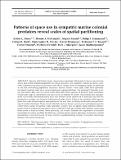Files in this item
Patterns of space use in sympatric marine colonial predators reveals scales of spatial partitioning
Item metadata
| dc.contributor.author | Jones, Esther Lane | |
| dc.contributor.author | McConnell, Bernie J | |
| dc.contributor.author | Smout, Sophie Caroline | |
| dc.contributor.author | Hammond, Philip Steven | |
| dc.contributor.author | Duck, Callan David | |
| dc.contributor.author | Morris, Christopher | |
| dc.contributor.author | Thompson, David | |
| dc.contributor.author | Russell, Deborah Jill Fraser | |
| dc.contributor.author | Vincent, Cecile | |
| dc.contributor.author | Cronin, Michelle | |
| dc.contributor.author | Sharples, Ruth Jemma | |
| dc.contributor.author | Matthiopoulos, Jason | |
| dc.date.accessioned | 2016-08-27T23:34:32Z | |
| dc.date.available | 2016-08-27T23:34:32Z | |
| dc.date.issued | 2015-08-27 | |
| dc.identifier | 193881978 | |
| dc.identifier | 58af22c6-0f96-4107-a881-bf027856cc5c | |
| dc.identifier | 84941287069 | |
| dc.identifier | 000360989500016 | |
| dc.identifier.citation | Jones , E L , McConnell , B J , Smout , S C , Hammond , P S , Duck , C D , Morris , C , Thompson , D , Russell , D J F , Vincent , C , Cronin , M , Sharples , R J & Matthiopoulos , J 2015 , ' Patterns of space use in sympatric marine colonial predators reveals scales of spatial partitioning ' , Marine Ecology Progress Series , vol. 534 , pp. 235-249 . https://doi.org/10.3354/meps11370 | en |
| dc.identifier.issn | 0171-8630 | |
| dc.identifier.other | ORCID: /0000-0002-2381-8302/work/47531632 | |
| dc.identifier.other | ORCID: /0000-0002-1969-102X/work/49052055 | |
| dc.identifier.other | ORCID: /0000-0002-4409-5860/work/30363092 | |
| dc.identifier.other | ORCID: /0000-0001-7575-5270/work/56052217 | |
| dc.identifier.other | ORCID: /0000-0003-1546-2876/work/56862198 | |
| dc.identifier.uri | https://hdl.handle.net/10023/9386 | |
| dc.description | E.L.J. and D.J.F.R. were funded under Scottish Government grant MMSS001/01. D.J.F.R. was funded by the UK Department of Energy and Climate Change (DECC) as part of their Offshore Energy Strategic Environmental Assessment programme. S.S. was part-funded by the EU MYFISH project. | en |
| dc.description.abstract | Species distribution maps can provide important information to focus conservation efforts and enable spatial management of human activities. Two sympatric marine predators, grey seals Halichoerus grypus and harbour seals Phoca vitulina have overlapping ranges on land and at sea but contrasting population dynamics around Britain: whilst grey seals have generally increased, harbour seals have shown significant regional declines. We analysed two decades of at-sea movement data and terrestrial count data from these species to produce high resolution, broad-scale maps of distribution and associated uncertainty to inform conservation and management. Our results showed that grey seals use offshore areas connected to their haul-out sites by prominent corridors and harbour seals primarily stay within 50km of the coastline. Both species show fine-scale offshore spatial segregation off the east coast of Britain and broad-scale partitioning off western Scotland. These results illustrate that for broad-scale marine spatial planning, the conservation needs of harbour seals (primarily inshore, the exception being selected offshore usage areas) are different from those of grey seals (up to 100km offshore and corridors connecting these areas to haul-out sites). More generally, our results illustrate the importance of detailed knowledge of marine predator distributions to inform marine spatial planning; for instance, spatial prioritisation is not necessarily the most effective spatial planning strategy even when conserving species with similar taxonomy. | |
| dc.format.extent | 1353043 | |
| dc.format.extent | 2370809 | |
| dc.language.iso | eng | |
| dc.relation.ispartof | Marine Ecology Progress Series | en |
| dc.subject | Halichoerus grypus | en |
| dc.subject | Phoca vitulina | en |
| dc.subject | Density estimation | en |
| dc.subject | Propagating uncertainty | en |
| dc.subject | Species distribution | en |
| dc.subject | Telemetry | en |
| dc.subject | Area-based conservation | en |
| dc.subject | QL Zoology | en |
| dc.subject | QH301 Biology | en |
| dc.subject | SDG 14 - Life Below Water | en |
| dc.subject.lcc | QL | en |
| dc.subject.lcc | QH301 | en |
| dc.title | Patterns of space use in sympatric marine colonial predators reveals scales of spatial partitioning | en |
| dc.type | Journal article | en |
| dc.contributor.institution | University of St Andrews. School of Biology | en |
| dc.contributor.institution | University of St Andrews. Scottish Oceans Institute | en |
| dc.contributor.institution | University of St Andrews. Marine Alliance for Science & Technology Scotland | en |
| dc.contributor.institution | University of St Andrews. Sea Mammal Research Unit | en |
| dc.contributor.institution | University of St Andrews. Centre for Research into Ecological & Environmental Modelling | en |
| dc.identifier.doi | https://doi.org/10.3354/meps11370 | |
| dc.description.status | Peer reviewed | en |
| dc.date.embargoedUntil | 2020-08-27 |
This item appears in the following Collection(s)
Items in the St Andrews Research Repository are protected by copyright, with all rights reserved, unless otherwise indicated.


